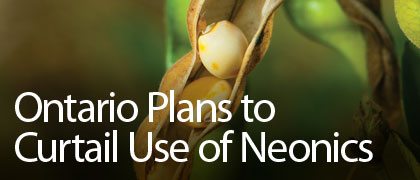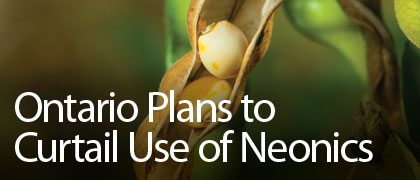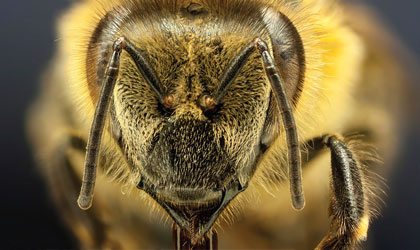
In light of new regulations, companies and farmers must get creative in their management strategies.
During the last week of November, the government of Ontario proposed regulations to curtail the use of neonicotinoid seed treatments on corn and soybean seeds by 80 per cent.
Ontario’s Ministry of Agriculture, Food and Rural Affairs proposed a three-point strategy to help ensure healthy ecosystems and a productive agricultural sector, while reducing the downward trend of pollinators.
The strategy includes: an 80 per cent reduction in acreage planted with neonicotinoid treated corn and soybean seed by 2017; limiting the number of honeybees that die during the winter by 15 per cent by 2020; and developing a comprehensive action plan for pollinator health.
“Improving pollinator health is not a luxury but a necessity,” says Glen Murray, provincial environment minister. “Pollinators play a key role in our ecosystem and without them, much of the food we eat would not be here. Taking strong action now to reduce the use of neurotoxic pesticides and protecting pollinator health is a positive step for our environment and the economy.
According to the ministry, it will work with stakeholders on a proposal to reduce the use of neonicotinoid treated seeds and hopes to have new rules in place by July 1, 2015, for the 2016 planting season.
Ontario, through its Environment and Regulatory Registries, released a discussion paper on pollinator health that was available for comment for 60 days. Following the comment period, it held consultation sessions in December and will host more in January.
As of now, this means starting in 2016, farmers in Ontario who want to use neonicotinoid treated seed must take an integrated pest management course, prove that he or she is implementing the IPM strategies and demonstrate that insect pressure on the farm is at a threshold that warrants the use of these seed treatments.
“It is possible for neonicotinoids to run off from fields to nearby water bodies where they can cause harm to aquatic insects and affect the animals that feed on those insects,” according to a government news release.
However, Canadian Seed Trade Association President Dave Baute says this is a slippery slope. “The sad truth is there is not science that supports the kind of knee-jerk reaction the province is taking,” Baute says, noting that this only creates unnecessary burden for the province’s seed industry and threatens the economics of growing corn and soybeans in Central Canada.
Mike McFatrich, BASF’s director of seed solutions business management, encourages his team to be creative in searching for solutions to cope with the changing regulatory climate.
Restricting the use of neonicotinoids could reduce revenues from corn and soybean production by more than $630 million per year in Ontario and the province’s gross domestic product would be cut by nearly $440 million if neonicotinoids were not available for use, according to a new report from the Conference Board of Canada.
The report, Seeds for Success: The Value of Seed Treatments for Ontario Growers, provides a new perspective on the costs of a hypothetical regulatory restriction on existing businesses and operators.
“For any significant change in regulations, it’s important for governments to consider the effects on individual farming businesses, as well as the broader costs and benefits,” says Vijay Gill, director of policy research with the Conference Board of Canada.
Not only will Ontario farmers lose potential revenue, Ontario would be forced to operate in isolation at an enormous competitive disadvantage to farmers elsewhere in North America, explains Henry Van Ankum, GFO chairman, noting that Health Canada’s Pest Management Regulatory Agency continues to license clothianidin, thiamethoxam and imidacloprid across the country.
Focus on Alternatives
BASF’s Mike McFatrich, director of seed solutions business management, says he respects Ontario’s decision and that the company is working to develop alternatives that will still deliver results.
“In Ontario, the cosmetic use of imidacloprids, one of the neonicotinoids, has been taken off the table for quite some time,” McFatrich says. “One of the areas within BASF — in this biological realm — that we’ve been looking at is the use of beneficial nematodes, for example.”
McFatrich explains that the ban on imidacloprids for cosmetic use means they it can’t be used to control grubs or lawn pests.
“One of the areas BASF has pioneered and developed to deal with grubs is the use of beneficial nematodes, which are microscopic worms that occur naturally and that we concentrate,” McFatrich says, adding that these beneficial nematodes have successfully been used in Ontario’s lawn care industry for about three years now. “This means that we have to be more creative. We have to understand the situation with regard to the climate in which we are working, and I think that we have solutions that can contribute to dealing with regulatory changes that occur.”
Ontario isn’t the only place where there’s been a lot of resistance to neonicotinoids; Europe has, too.
“One of the things we are looking at in Europe is what are the tools that we have, in terms of biological crop products that allow a plant to withstand low levels of damage and still be able to grow in an efficient way that provides yield,” McFatrich says. “Understanding the system, understanding the challenges of the pest and being able to be innovative and flexible to provide a solution — I think it’s all part of making sure that we are able to stay ahead of the challenges that we face with producing a crop.”
McFatrich says this is an area that BASF continues to work in and explore.
Beekeepers and seed companies strive to improve the health of Canada’s bee populations, but controversary remains.
The Sting
Meanwhile, beekeepers keep their defenses up. Back in September, Sun Parlor Honey and Munro Honey filed a class action suit against the Canadian branches of Bayer CropScience and Syngenta and their parent companies. The suite was filed on behalf of Canadian beekeepers and honey producers alleging negligence and claiming more than $450 million in damages.
But Bayer, which is reportedly the largest purchaser of pollination services in Canada to support its canola seed business, says it has “an abiding interest in bee health.” But its Canadian canola business also depends on neonicotinoid-treated seed.
“As a leader in agriculture, we understand the value of pollinators to agriculture and have an inherent interest in helping find solutions to the problem of honeybee health,” the company reports.
The Ontario Beekeepers Association, which is not directly involved in the suit supports any effort that could help beekeepers recover loses caused by the use of neonicotinoids.
“This action puts the blame where it belongs — on the pesticide manufacturers,” says Tibor Szabo, Ontario Beekeepers Association first vice-president.
But the Alberta beekeepers disagree with the actions of the Ontario beekeepers. “The Ontario Beekeepers Association has taken a very active political stance on it, whereas Alberta and some other provinces have the feeling that it is better to work together to come to a resolution,” says Kevin Nixon, Canadian Honey Council vice-chair and an Innisfail beekeeper. “For the past couple of years, it almost seemed like the Ontario beekeepers were speaking on behalf of the Canadian industry.”
Nixon says it feels like Ontario beekeepers are “almost pitting farmer against farmer and beekeepers against growers.·
“We have a good relationship with our growers here in Alberta and we don’t want to take a negative position on it,” he says.
President of the Alberta Beekeepers Commission Grant Hicks says, “we’re not being impacted by neonics,” and if they are it’s very subtle.
Hicks, who is reluctant to take on chemical companies, says he relies on those same companies for chemicals to control Varroa mites.
“We knock those mites down with chemicals,” he says. “We have to work with the same companies that the Ontario beekeepers are suing, to keep our hives alive. To be perfectly clear, there are no good insecticides in a beekeepers’ world, except for the ones we want to use.”
Hicks believes bee losses in Ontario shouldn’t be blamed solely on neonicotinoid seed treatments. Varroa mites, weather and poor nutrition all come into play, he explains.
More Research
A honeybee health surveillance study will be completed to document the health of Canadian honeybees. The Alberta Beekeepers Commission, representing 60 per cent of Canada’s honey crop, submitted a grant proposal to conduct a Canada-wide honeybee health surveillance study, which has been approved by Agriculture and Agri-Food Canada.
The study will build on the surveillance that’s been completed at a regional level and will provide crucial information to continue to look at all the factors affecting honeybee health.
Led by Carlos Castillo and his team at the National Bee Diagnostic Centre in Beaverlodge, Alta., the study will be completed throughout the next four years.
Julie Deering














